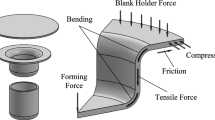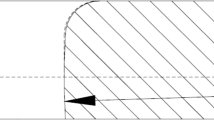Abstract
Deep drawing is a forming process widely used in aerospace, military, automotive, and various industries. One of the essential useful parameters in the quality of deep-drawn products is blank holder force (BHF). By controlling BHF during the forming process, formability can be improved and it can reduce forming energy. Tearing is one of the most common and crucial defects in this process due to high radial stress in the cup’s wall, resulting in many limitations in this field. In this process, the BHF plays an indispensable role in causing tearing. Therefore, controlling BHF during the process would be inevitable to avoid tearing or even wrinkling. This study aims to calculate the tearing limit with new criteria in analytical dominating plasticity equations based on the slab method. The St14 sheet with 1 mm thickness and 200 mm diameter is used in this study. The maximum BHF in each stage of punch stroke with new criterion based on strain energy with three different frictional coefficients is calculated, compared, and verified with FEM simulation and experimental results. Analytical results with new criterion are also compared with previous procedures. Finally, it is realized that results related to energy criteria have a lot more similarity with FEM simulation and experimental results in comparison with the previous methods.














Similar content being viewed by others
Availability of data and materials
All data, material, and codes used in this paper are available.
Code availability
All data, material, and codes used in this paper are available.
References
Tisza M (2020) Development of lightweight steels for automotive applications. Eng Steels High Entropy-Alloys IntechOpen
Szyndler J, Madej L (2015) Metalforming methods dedicated for the aerospace industry. Comput Methods Mater Sci 15:294–310
Trzepieciński T (2020) Recent developments and trends in sheet metal forming. Metals (Basel) 10:779
Prakash V, Kumar DR (2020) Performance evaluation of bio-lubricants in strip drawing and deep drawing of an aluminum alloy. Adv Mater Process Technol 1–14
Dwivedi R, Agnihotri G (2017) Study of deep drawing process parameters. Mater Today Proc 4:820–826
Tenner J, Andreas K, Radius A, Merklein M (2017) Numerical and experimental investigation of dry deep drawing of aluminum alloys with conventional and coated tool surfaces. Procedia Eng 207:2245–2250
Xiao W-C, Wang B-Y, Kang Y, Ma W-P, Tang X-F (2017) Deep drawing of aluminum alloy 7075 using hot stamping. Rare Met 36:485–493
Habibi M, Hashemi R, Tafti MF, Assempour A (2018) Experimental investigation of mechanical properties, formability and forming limit diagrams for tailor-welded blanks produced by friction stir welding. J Manuf Process 31:310–323
Aminzadeh A, Parvizi A, Moradi M (2020) Multi-objective topology optimization of deep drawing dissimilar tailor laser welded blanks; experimental and finite element investigation. Opt Laser Technol. https://doi.org/10.1016/j.optlastec.2019.106029
Aminzadeh A, Parvizi A, Safdarian R, Rahmatabadi D (2020) Comparison between laser beam and gas tungsten arc tailored welded blanks via deep drawing. Proc Inst Mech Eng Part B J Eng Manuf. https://doi.org/10.1177/0954405420962391
Padmanabhan KA, Prabu SB, Mulyukov RR, Nazarov A, Imayev RM, Chowdhury SG (2018) Superplastic forming, analyses and industrial applications. Springer, Superplasticity, pp 359–428
Afshin E, Kadkhodayan M (2015) An experimental investigation into the warm deep-drawing process on laminated sheets under various grain sizes. Mater Des 87:25–35
Reddy ACS, Rajesham S, Reddy PR, Kumar TP, Goverdhan J (2015) An experimental study on effect of process parameters in deep drawing using Taguchi technique. Int J Eng Sci Technol 7:21–32
Demirci HI, Esner C, Yasar M (2008) Effect of the BHF on drawing of aluminum alloy square cup: theoretical and experimental investigation. J Mater Process Technol 206:152–160
Choudhari CS, Khasbage SS (2020) Experimental investigation of forming parameters for square cup deep drawing process. Mater Today Proc
Rubio EM, Camacho AM, Sevilla L, Sebastian MA (2005) Calculation of the forward tension in drawing processes. J Mater Process Technol 162:551–557
Agrawal A, Reddy NV, Dixit PM (2007) Determination of optimum process parameters for wrinkle free products in deep drawing process. J Mater Process Technol 191:51–54
Rubio EM (2006) Analytical methods application to the study of tube drawing processes with fixed conical inner plug: slab and upper bound methods. J Achiev Mater Manuf Eng 14:119–130
Bamdad AH, Hashemi R (2021) Analytical and numerical investigation of wrinkling limit diagram in deep drawing of two-layer sheets with experimental verification. Proc Inst Mech Eng Part L J Mater Des Appl 1464420720985315
Morovvati MR, Mollaei-Dariani B, Asadian-Ardakani MH (2010) A theoretical, numerical, and experimental investigation of plastic wrinkling of circular two-layer sheet metal in the deep drawing. J Mater Process Technol 210:1738–1747
Gharib H, Wifi AS, Younan M, Nassef A (2006) Optimization of the BHF in cup drawing. Optimization 1:8
Aminzadeh A, Karganroudi SS, Barka N (2021) A novel approach of residual stress prediction in ST-14/ST-44 laser welded blanks; mechanical characterization and experimental validation. Mater Lett 285:129193
Sugiyanto D, Asbanu H, Siahaan FS (2020) The effect of blank holder on the deep drawing process on plates using software based with a finite element method (FEM). J Phys Conf Ser 1469:12038
Bagherzadeh S, Mirnia MJ, Dariani BM (2015) Numerical and experimental investigations of hydro-mechanical deep drawing process of laminated aluminum/steel sheets. J Manuf Process 18:131–140
Yoshihara S, Manabe K, Nishimura H (2005) Effect of blank holder force control in deep-drawing process of magnesium alloy sheet. J Mater Process Technol 170:579–585
Sheng ZQ, Jirathearanat S, Altan T (2004) Adaptive FEM simulation for prediction of variable blank holder force in conical cup drawing. Int J Mach Tools Manuf 44:487–494
Qin S, Zhang H, Mao Y, Yang L, Li X, Hu Z et al (2020) Electropermanent magnet blank holder technique in sheet metal deep drawing. Int J Adv Manuf Technol 106:5497–5507
Lange K (1985) Handbook of Metal Forming. USA: Mc-Graw Hill, USA 20.1–20.66
Candra S et al (2015) Analytical study and FEM simulation of the maximum varying blank holder force to prevent cracking on cylindrical cup deep drawing. Procedia Cirp 26:548–553
Kitayama S et al (2010) A closed-loop type algorithm for determination of variable blank holder force trajectory and its application to square cup deep drawing. Int J Adv Manuf Technol 51(5–8):507–517
ASTM, E8–99 (2001) Standard test methods for tension testing of metallic materials. Annual book of ASTM standards. ASTM
Hu J, Marciniak Z, Duncan J (Eds.) (2002) Mechanics of sheet metal forming. Elsevier
Author information
Authors and Affiliations
Contributions
The authors’ contributions are as follows: Mohammad Khaboushani and Ahmad Aminzadeh conceived, planned, and carried out the experiments; Mohammad Khaboushani and Ahmad Aminzadeh contributed to the measurement interpretation, visualization, and analyses of results. Ali Parvizi took the lead in writing the manuscript, and Mohammad Khaboushani, Ahmad Aminzadeh, and Ali Parvizi contributed actively to writing the manuscript; all authors provided critical feedback and helped shape the research, analysis, and manuscript.
Corresponding author
Ethics declarations
Ethical approval
This article does not involve human or animal participation or data; therefore, ethics approval is not applicable.
Consent to participate
This article does not involve human or animal participation or data; therefore, consent to participate is not applicable.
Consent to publish
This article does not involve human or animal participation or data; therefore, consent to publish is not applicable.
Competing interests
The authors declare no competing interests.
Additional information
Publisher's Note
Springer Nature remains neutral with regard to jurisdictional claims in published maps and institutional affiliations.
Rights and permissions
Springer Nature or its licensor holds exclusive rights to this article under a publishing agreement with the author(s) or other rightsholder(s); author self-archiving of the accepted manuscript version of this article is solely governed by the terms of such publishing agreement and applicable law.
About this article
Cite this article
Khaboushani, M., Aminzadeh, A. & Parvizi, A. A novel estimation of tearing limit in deep drawing process based on strain energy; experimental characterization and numerical validation. Int J Adv Manuf Technol 123, 927–942 (2022). https://doi.org/10.1007/s00170-022-10158-7
Received:
Accepted:
Published:
Issue Date:
DOI: https://doi.org/10.1007/s00170-022-10158-7




